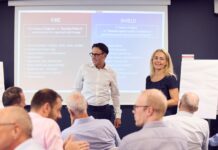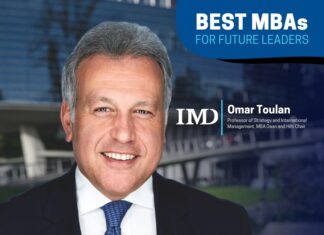Traditional leadership development programmes operate with a one-size-fits-all mentality. Below, John Sutherland argues that the key to developing the right kind of leadership skills for your organisation lies in creating, and continually refining, your own programme, and outlines five crucial principles that need to be taken into account when doing so.
You have worked hard to create your vision and turn it into a detailed strategy. It is an exciting time and the potential for value creation is credible, based on your analysis of the total addressable market, your competitors and potential acquisitions, and your strengths. So far so good. Now you cast your eyes over your organisation and ask the killer question: do we have the leadership skills we need to deliver our strategy? Do we even have the skills we need to complete the current plan, in order to earn the right to go onto the next phase of the plan? For most firms the answer is no, often to both questions.
If there is a yawning gap between the skills you need and the ones in evidence, what are your options? Here are 5 principles we have found to be effective, based on the newly emerging disruptive technology in leadership development.
1. Co-design your leadership programme around the specific skills you need to close the gap
This may seem like common sense but, unfortunately, it is not currently a common feature of traditional leadership programmes. Most are ‘by the book’ and are based on an analysis of what the average business leader need. They are generic, standard and sold on the ‘tried and tested’ ticket. The logic offered is that if it worked for company x, who are truly impressive, surely it will work for you. But it won’t. General leadership development is, usually, useless for meeting your specific needs. You need the precise leadership skills that will close the gap between your current performance and your future vision. So the first task is to get very clear about the actual skills gap you have and to co-design a programme that perfectly fits your circumstances and requirements. Most programmes are not designed this way, even though it seems like an obvious thing to do.
Peter’s organisation had two obvious gaps. The first was the need for a real step-up in delivery and follow-through skills. No point adding new strategic projects to a long list of unfinished ones. The second was internal coaching. They were losing the talent they wanted to keep because those on a rapid career trajectory did not think they were being sufficiently developed. Peter’s organisation did not need a complicated design to deliver the results he was after. All he needed was a couple of modules. Sometimes less is more, as it keeps it crisp and to the point.
Peter’s own experience of leadership development was of the traditional variety: the good and the great imparted their wisdom, which was then discussed in small groups through a series of rather well-worn scenarios, in the hope this would impart understanding. Peter said that those who attended had all got something out of it and had particularly enjoyed the small group discussion work. But it had not met his specific needs and, of course, it was not designed to. To do that your programme needs to be designed from the ground up, specifically for your organisation.
2. Focus the development around the delivery of real work
The most reliable and robust way to ensure that you end up with leadership skills that work in practice in your organisation is to develop the skills required during business as usual, preferably on-site. Lashing a raft together to cross a lake may be fun but has the obvious problem that you then need to work out how to transfer any learning that occurred half way across the lake back into the real world of work. All too often whatever learning does result from such activities sinks like a stone. Far more useful is to develop the skills around the delivery of your current priorities. Not only do you get facilitation of your key projects, but you also have leaders focussed on the exact skills that are needed for success. An additional benefit is that it minimises the time spent just on development, because they are learning whilst performing the day job. If they are focussed on your strategic priorities it is likely that you will get yet another advantage, as this will require your leaders to learn how to work together to make progress. Strategic leadership usually requires effective collaboration to be effective.
In Hans Olav’s organisation most of the strategic projects required effective matrix management, rather than mere collaboration, and this was something they had struggled to achieve since making a major acquisition a few years before. Focusing the development work around their 5 strategic projects meant that not only did they evolve effective cross-functional teamwork, but it also provided much needed coherence across their Europe-wide business. Delivering the 5 projects became their laser-like focus and, over time, the leadership programme became synonymous with delivering the strategic plan. In practice this resulted in the programme being timed to fit in with the ‘drum beat’ and rhythm created by implementing the strategic plan, rather than being something people had to attempt to fit in around already over-packed diaries.
3. Plan for continuous improvement
If you follow the two steps detailed so far you will be way ahead of the competition, but let’s keep you there. Each time you run an element of your leadership programme you are going to learn something about how to refine what works well and about the precise skills needed to make your vision a reality. So co-design your programme on the assumption that it will keep on evolving as the picture of what is required sharpens from slightly blurry into high definition. Traditional programmes, of course, do the opposite. They set out a standard workshop format and crank the handle, sheep-dip wise, so that everyone ‘enjoys’ the same experience. Whatever element is missing from those programmes remains absent and the gap stays stubbornly open. Even worse, whatever element shows promise of working really well is simply repeated, rather than refined, minimising advantage.
One of the key elements of the new disruptive technology in leadership development is the shift from telling leaders what they should learn to expecting them to identify for themselves the key areas of development required for the delivery of their individual and corporate objectives. The process raises the bar for leadership development. Who better, after all, to specify the precise skills needed and refine how to use them effectively than the very leaders you have charged with the responsibility of discharging your plan?
Back to Hans Olav’s organisation. It was only when the leaders really got down to the details of how to use the matrix to deliver their strategic projects that it became clear there was a major disconnect between sales and operations. When quality issues arose, leading to a delay in manufacturing, there was an insufficient grasp of the impact this would have on the sales team’s ability to hit the month end sales figures, leading to a permanent state of frenzied activity. The missing skill was identifying and acting on strategic implications across the matrix, and, as it turned out, not just between sales and operations.
4. Stay with it until the required skills become mastered
We’ve all been there. You send people on an expensive development programme and the initial feedback is positive, but three months down the track there is scant evidence of any permanent change of behaviour, let alone improved performance. You can teach an old dog new tricks but it takes more repetition, effort and time than can ever be achieved in a two day off-site programme. Our new understanding of how the brain changes as we evolve new neural pathways tells us that there has to be a significant focus on following through the learning for 3-4 months after the formal part of the programme is over. In cost terms we recommend that the follow through budget is about one third of the overall development costs.
A small group of leaders who commit to supporting each other’s learning goes a long way to turning your required skills into new habits. It is asking too much to expect individuals to maintain momentum by themselves. We tend to support the process by providing monthly internet based facilitation, as this provides another spur to maintain the focus long enough to allow true mastery to emerge. You can always identify those who have endured the learning process. They are easily able to demonstrate the skill on demand and have learnt to make it their own, fitting their unique personality and strengths. Paul was a classic case in point. In his UK based health and safety business he had learnt how to deal with conflict confidently enough to be able to go straight to the heart of heated differences between team members. His assurance gave others the space to give voice to the issues that were lurking behind their simmering disagreements. All this from a person who described himself as conflict adverse at the start of the leadership work. He had changed.
As your leaders master new habits there emerges a sense of cohesion across the organisation – you evolve an identifiable company style. In Peter’s organisation it was their growing reputation for delivery that became their hallmark. When they said they were going to do something their word was their bond. Not a bad brand when it is customers who are providing the feedback, rather than internal PR or marketing people being ‘aspirational’.
5. Expect to make a return on your investment in leadership development
Assuming you have based your leadership development work on the first four guiding principles you will be well placed to make a healthy return on investment, or at worst have the programme become cost-neutral. Focussing the development around the delivery of your business plan means you are likely to already have Management Information Systems for calculating the positive impact of the programme. We recommend doing this as a cumulative track of each individual’s contribution, rather than simply comparing your before and after EBITDA numbers, as this provides more granularity on the specifics of who did what and how it all added up to progress.
Expecting to make a return on investment is key for a couple of reasons. The first is obvious: like any other business decision, if you cannot see a pay back within a reasonable time scale then why would you run the programme in the first place? It has to wash its face. The second is a little more subtle. It is a leadership programme and leaders are paid a lot of money to make a difference and produce results. So, if your leadership programme is correctly co-designed, it should magnify their impact in a tangible way and add to the bottom line.
And finally, there are, as you might expect, some elements of leadership development that tend to be required whatever your specific business plan is. Of these the most important, in our experience, is work on emotional competence. It is a thread that certainly runs through all the development we are asked to co-design. If a leader always needs to feel in control this will get in the way of developing their collaboration skills. If a leader avoids conflict they will struggle to confront poor performance in others. Work on emotional competence is crucial for unlocking leadership potential.
It does take more effort and innovation to define – and then refine – your own programme rather than import someone else’s, but the rewards are compelling. The early CEO adopters of this disrupting technology have already proved the concept is effective. How will you close the gap?
About the Author
 John Sutherland is the Director of the Leadership Initiative, which provides leadership development focussed on delivering the business plan and producing a solid return on investment. He also runs Strategic Resource, which provides a suite of services for the investment community. [email protected]
John Sutherland is the Director of the Leadership Initiative, which provides leadership development focussed on delivering the business plan and producing a solid return on investment. He also runs Strategic Resource, which provides a suite of services for the investment community. [email protected]
+44 15394 66000

























![“Does Everyone Hear Me OK?”: How to Lead Virtual Teams Effectively iStock-1438575049 (1) [Converted]](https://www.europeanbusinessreview.com/wp-content/uploads/2024/11/iStock-1438575049-1-Converted-100x70.jpg)






